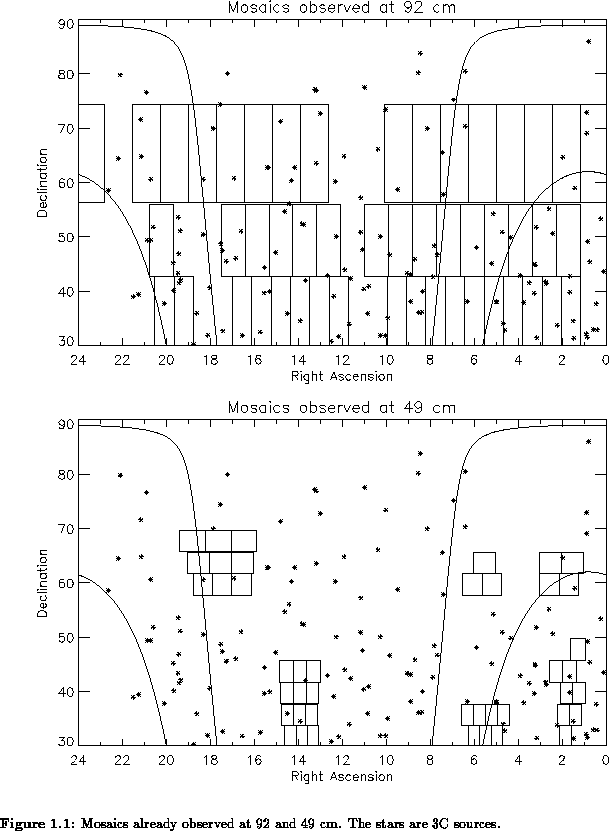The Westerbork Northern Sky Survey is a survey presently carried out with
the WSRT. The entire sky above declination degrees is mapped at
a wavelength of 92 cm (10,000 square degrees). At 49 cm we hope to map
at least one third of that area (3,000 - 4,000 square degrees). Mapping
the same region as we have planned at 92 cm is just not possible. The
amount of observing time would be 3 times larger as with 92 cm since
the field of view is twice as small (the field of view is proportional
with the wavelength). Also the amount of time that is needed for reducing
the data would become too large. At the present time the reduction and
catalogue building can keep pace with the datastream from the telescope
(observing, initial calibration and archiving of the raw data). The limiting
flux density at both wavelengths should be between 10 - 15 mJy
(
level).
The result would be a catalogue with about 300,000 sources at 92 cm and 60,000 sources at 49 cm. Because the catalogue consists of two observed frequencies, we have direct spectral information available for a large fraction of the sources. This means that we can produce a large database of radio sources and with this database we can select and study these sources more than one order of magnitude deeper in flux than was previously possible. Also the positional accuracy would be much better that all previous surveys (a few arcseconds for the faint sources and about one arcsecond for the brightest ones).
All Stokes parameters I, Q, U and V are recorded, so also polarization maps will be produced. These maps will be used for polarization studies for a large fraction of double radio sources, for finding millisecond pulsars and to study the plasma and magnetic field properties in our own Galaxy.
An efficient telescope calendar has been used to complete the WENSS
survey. This is essential because of the large amount of telescope
time needed to complete the project. The WSRT is a synthesis array
with a 12 hour observing cycle, so two regions of sky separated by 12
hours can be observed in a 24 hour period (the survey covers all right
ascension between and
). Between two observations only
15 minutes are lost, due to the repositioning of the telescopes to the
starting point in the next mosaic. Leaving two half-days for
maintenance and development (during daytime) as well as array
reconfigurations (moving telescopes AB and CD) leads to a total of 12
mosaics (each consisting of one
observation) per week.
The observations will be made in the period 1991-1995. It will take
about 1 year net observing with the WSRT to complete the survey. At 92
cm about 75 mosaics are needed. At 49 cm it is impossible to cover the
same area of sky as with 92 cm. The grid separation at 49 cm is a
factor of 1.87 smaller, hence the number of fields about 3.5 times
larger. The total amount of time spend per field at 49 cm is only
of that spend at 92 cm, so assuming a similar period of
observing, we estimate to complete only 3000-4000 square degrees at 49 cm.
The WENSS database will be used as a starting point for further astronomical observations, both galactic and extra-galactic. When the survey becomes available the WSRT will be upgraded with the new Multi Frequency Front Ends and a considerably more powerful backend. Also other telescopes will be used for follow up observations like the VLA (New Mexico), WHT and INT (La Palma). The most important subjects that we are interested in are galaxy evolution and formation, Giga Hertz Peakers, radio source aging, polarization studies, radio bright spiral galaxies, exotic objects, large scale studies of clustering of galaxies, variable sources and galactic radio stars.
